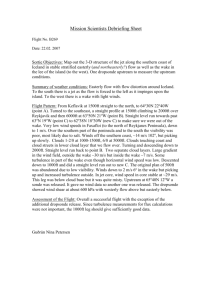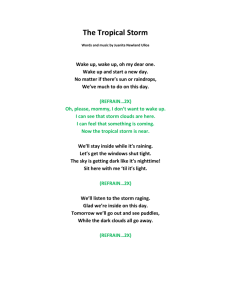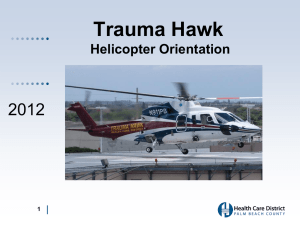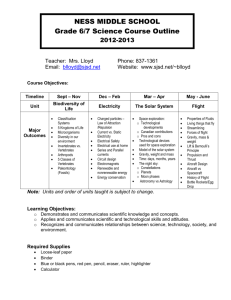Wake Turbulence Awareness / Avoidance
advertisement
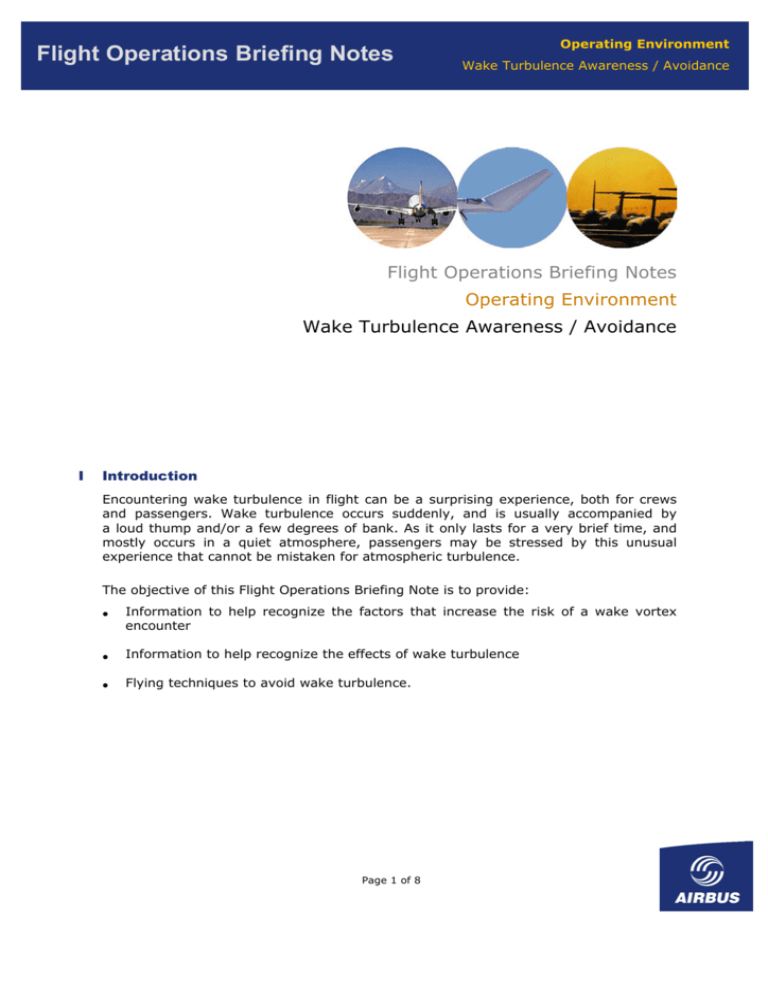
Flight Operations Briefing Notes Operating Environment Wake Turbulence Awareness / Avoidance Flight Operations Briefing Notes Operating Environment Wake Turbulence Awareness / Avoidance I Introduction Encountering wake turbulence in flight can be a surprising experience, both for crews and passengers. Wake turbulence occurs suddenly, and is usually accompanied by a loud thump and/or a few degrees of bank. As it only lasts for a very brief time, and mostly occurs in a quiet atmosphere, passengers may be stressed by this unusual experience that cannot be mistaken for atmospheric turbulence. The objective of this Flight Operations Briefing Note is to provide: • Information to help recognize the factors that increase the risk of a wake vortex encounter • Information to help recognize the effects of wake turbulence • Flying techniques to avoid wake turbulence. Page 1 of 8 Operating Environment Flight Operations Briefing Notes II Wake Turbulence Awareness / Avoidance Background Information – Statistical Data Wake Turbulence Accidents per Aircraft Category Heavy 1% Medium 9% Light 19% Small 71% Wake Turbulence Accidents per Flight Phase Maneuvering 12% Cruise 5% Takeoff 13% Approach 70% Figure 1 US Wake Turbulence Accidents, 1983-2002 (Source: Flight Safety Foundation – Flight Safety Digest March-April 2002) Note: The Maneuvering category includes anything that cannot occur during takeoff, cruise, and approach (e.g., circling for spacing, low speed flight for training, etc.). Studies and statistical data about wake turbulence indicate that: • Most accidents, due to wake turbulence, occur during approach at very low heights (less than 200 feet above the runway threshold) • 90 percent of wake turbulence accidents involve aircraft that weigh less than 13 600 kg (30 000 lb) • In 99 percent of the reported events, the effects of wake turbulence are abrupt and occur without any advance warning. Page 2 of 8 Flight Operations Briefing Notes III Operating Environment Wake Turbulence Awareness / Avoidance Applicable Standards / Techniques / Best Practices III.1 Vortex Characteristics Due to the fact that there is no technical way to visualize aircraft wake vortices, it is important to understand their physical characteristics, in order to be able to mentally anticipate potential zones of encounter. The main characteristics of aircraft wake vortices are: • Sink rate: 300 to 500 feet/minute • Stabilization at 500 to 900 feet under the aircraft at the origin of the vortices • Lateral movement at 5 knots, when reaching the ground • Life span: − Approximately 30 seconds, with a wind speed between 5 and 10 knots − Up to 85 seconds, when the wind speed is less than 5 knots − Up to 100 seconds in still air. Figure 2 Aircraft Wake Vortices Page 3 of 8 Flight Operations Briefing Notes Operating Environment Wake Turbulence Awareness / Avoidance III.2 Regulation Aspect (ICAO) Air traffic controllers are requested to respect a minimum longitudinal spacing, when the vertical separation is less than 1 000 feet: Leading Aircraft Following Aircraft Heavy Separation in NM (MTOW≥ 136000 kg) Medium Light (7000 kg<MTOW<136000 kg) (MTOW≤7000 kg) Heavy 4 5 6 Medium 3 3 5 Note: There have been numerous reports of wake turbulence events involving aircraft separated by these minimum values (or slightly less). The purpose of the ICAO regulation is to prevent accidents, however, it does not ensure total vortex avoidance. IV Environmental and Operational Factors Affecting the Risk of a Wake Vortex Encounter IV.1 Environmental Factors Increasing the Risk of a Wake Vortex Encounter The probability of encountering wake vortices during approach largely depends on weather conditions. The following factors increase the probability of a vortex encounter: • Heavy, slow, and clean leading aircraft • Leading aircraft performing a go around • Parallel or crossing runways • Visual Meteorological Conditions (VMC), because of the reduction in separation between aircraft during visual approaches • Light crosswind (3 to 10 knots) or tailwind • Stable atmosphere, temperature inversion (at sunrise for example) • Flat surrounding terrain • During the final descent, a tailwind can bring wake vortices back to the glide path (Figure 3). Page 4 of 8 Flight Operations Briefing Notes Operating Environment Wake Turbulence Awareness / Avoidance Figure 3 Wake Turbulence in Tailwind IV.2 Operational Factors Increasing the Risk of a Wake Vortex Encounter Depending on the situation, it can be either the flight crew’s, or the air traffic controller’s, responsibility to provide sufficient separation between two aircraft to avoid a wake turbulence encounter. As long as Instrument Meteorological Conditions (IMC) exist, only the air traffic controller is able to maintain the spacing, by issuing appropriate instructions. The air traffic controller’s responsibility is, in fact, extended to any flight phase in which the aircraft is radar-vectored. Air traffic controllers are also responsible for providing correct information regarding wake turbulence separation at takeoff. However, this responsibility is transferred to the flight crew, when the flight crew accepts to: V • Maintain a visual separation • Fly a visual approach. Prevention Strategies / Lines of Defense Short-wingspan aircraft will be more sensitive to a specific vortex than long-wingspan aircraft. Even high-performance aircraft (e.g, a jet fighter) will be more sensitive to wake turbulence than a civilian transport aircraft, because of its short wingspan. Always notify the ATC of what separation is needed, in order to avoid suspected wake turbulence (speed reduction, trajectory change …). Note: If wake turbulence is encountered, the flight crew should not attempt to counter turbulence using rudder control. Page 5 of 8 Flight Operations Briefing Notes Operating Environment Wake Turbulence Awareness / Avoidance Wake vortex avoidance strategy should be adapted to each flight phase: • • • Takeoff and Climb − When the flight crew identifies the factors that increase the life span of wake turbulence, they should request a 2 to 3 minute delay in takeoff. − If possible, the flight crew must ensure that the aircraft climbs above the leading aircraft trajectory. If not, the aircraft must remain upwind of the leading aircraft trajectory. − Headings that may lead the aircraft to cross the preceding aircraft trajectory, behind and below the leading aircraft, should be avoided. Cruise − Wake turbulence events are more frequent in RVSM airspace, even with very distant aircraft (20 NM). The flight crew should consider keeping the seat belt signs ON, when the aircraft proximity is known. − If necessary, the flight crew may offset from the cleared track, by up to a maximum of 2NM, in order to alleviate the effects of wake turbulence. The ATC should be advised of this contingency action, but will not issue clearance for this type of lateral offset. The aircraft should be returned to the cleared track as soon as possible. − It is important to note that wake turbulence can cause variation in pitch. When crossing a vortex perpendicularly, these pitch variations are sometimes accompanied by a loud thumping noise. During an approach at night, passengers may have the sensation that the aircraft has touched the ground. Approach − If feasible, check the spacing with the leading aircraft by using the TCAS display. A visual estimation of the horizontal spacing is not sufficient and should not be trusted. − If flying a medium or heavy aircraft, the flight crew should pay particular attention to being exactly on the glide path, not above it. This will keep the wake turbulence below the glide path, and may protect other aircraft from being trapped in the wake vortex. Note: If the flight crew accepts a visual separation, they are also responsible for wake turbulence avoidance. • Landing − When possible, the flight crew should land the aircraft beyond the touchdown point of the preceding aircraft. Note: If another aircraft crosses the active runway shortly before landing, a lateral jerk may result from crossing the jet blast. Page 6 of 8 Flight Operations Briefing Notes VI Operating Environment Wake Turbulence Awareness / Avoidance Summary of Key Points It is important to note the following key points: • • VII VIII − Maintain a visual separation − Fly a visual approach. The flight crew must closely monitor wake turbulence, when: − In VMC − The wind is calm, between 0 to 10 knots, with no gusts − Flat terrain is upwind of the runway − The atmosphere is stable. • The flight crew should be aware of surrounding traffic • The aircraft must remain upwind and above the preceding aircraft, in order to avoid wake turbulence • During wake turbulence, the flight crew should not use rudder control. Regulatory References • ICAO - Annex 2 - Rules of the Air • ICAO – Doc 4444 • FAA – AIM 7.3 - Wake Turbulence (http://www.faa.gov/atpubs/AIM/Chap7/aim0703.html) Airbus Reference • IX The responsibility for wake turbulence avoidance is transferred to the flight crew, when they have accepted to: Airbus Operations Policy Manual – Guide for JAR-OPS 1 Operations Manual (Part A) – Operating Procedures – Flight Procedures – Wake Turbulence Additional Reading Materials / Website References • FAA - Wake Turbulence Training Aid (http://www.faa.gov/AVR/AFS/wake/01wake.pdf) • FAA – National Aviation Safety Data Analysis Center (http://www.nasdac.faa.gov) • Flight Safety Foundation – Flight Safety Digest - March - April 2002 (http://www.flightsafety.org/pubs/fsd_2002.html) Page 7 of 8 Flight Operations Briefing Notes Operating Environment Wake Turbulence Awareness / Avoidance Figure 4 Light Aircraft Wake Vortex (Photo credit NASA) This FOBN is part of a set of Flight Operations Briefing Notes that provide an overview of the applicable standards, flying techniques and best practices, operational and human factors, suggested company prevention strategies and personal lines-of-defense related to major threats and hazards to flight operations safety. This FOBN is intended to enhance the reader's flight safety awareness but it shall not supersede the applicable regulations and the Airbus or airline's operational documentation; should any deviation appear between this FOBN and the Airbus or airline’s AFM / (M)MEL / FCOM / QRH / FCTM, the latter shall prevail at all times. In the interest of aviation safety, this FOBN may be reproduced in whole or in part - in all media - or translated; any use of this FOBN shall not modify its contents or alter an excerpt from its original context. Any commercial use is strictly excluded. All uses shall credit Airbus. Airbus shall have no liability or responsibility for the use of this FOBN, the correctness of the duplication, adaptation or translation and for the updating and revision of any duplicated version. Airbus Customer Services Flight Operations Support and Services 1 Rond Point Maurice Bellonte - 31707 BLAGNAC CEDEX FRANCE FOBN Reference : FLT_OPS – OPS_ENV – SEQ 07 – REV 01 – JUN. 2005 Page 8 of 8
